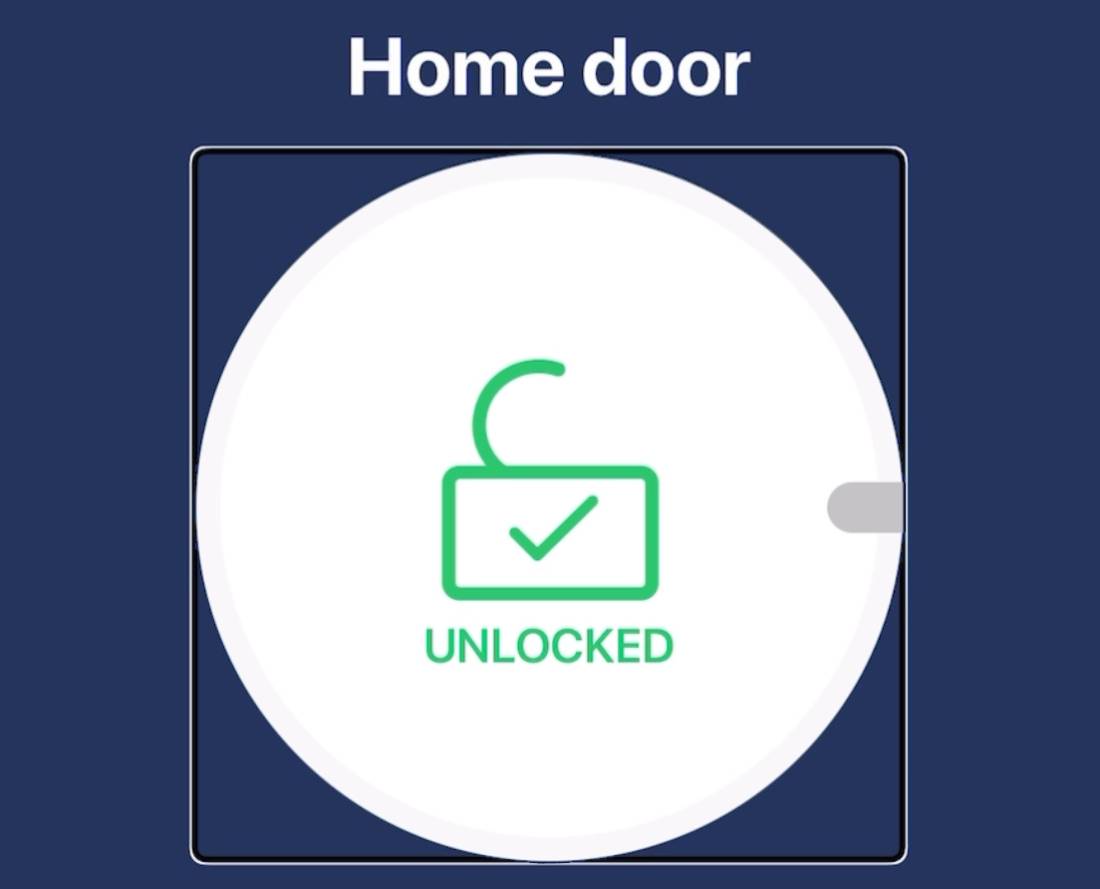
Tedee Makes Smart Access More Accessible to Users with Impaired Vision
By making doors smart, Tedee smart locks offer not only new convenience but also improved daily comfort for those seeking extra assistance, including individuals with impaired vision. The latest assistive features in the Tedee mobile app, designed for use with Tedee GO and Tedee PRO smart locks, make smart access control even more efficient and user-friendly.
Last year, we partnered with the Association for the Care of the Visually Impaired in Laski, Poland, and the Tono Praca Association, which is dedicated to integrating individuals with visual impairments into the workplace using modern assistive technologies. To implement a keyless access system for their campus guest room facilities, they reached out to GERDA, the co-creator of Tedee, and the local Tedee distributor. Our collaboration aimed to enhance our app’s features and extend the benefits of keyless living to an even broader audience.
Thanks to their significant support, expertise, and enthusiasm for innovative accessibility technologies, we completed our project and introduced several updates to our system. Following this achievement, we were invited to appear on Tyflopodcast, Poland’s premier assistive technology podcast, to discuss our innovative solutions. The Tyflopodcast episode featuring Tedee smart locks can be accessed in Polish after this link.
According to the European Blind Union, over 30 million blind and partially sighted individuals reside in geographical Europe. We believe that smart locks can play a significant role in their lives by not only increasing the convenience of securing their front doors but also by providing them with greater control and autonomy over their living spaces. Therefore, we aim to enhance the integration of assistive technologies with Tedee devices and apps to improve the quality of life for as many people as possible.
Continue reading the article to learn more about how smart locks function and how they can assist users with visual impairments.
Video where visually impaired influencer Adrian Now demonstrates and reviews the Tedee PRO smart lock, using his smartphone to interact with the device installed on his door.
What is a Smart Lock?
To properly introduce the topic, it is important to define what a smart lock is, especially in the context of Tedee products.
Tedee smart locks are compact, lemon-sized wireless electronic devices. A smart lock is installed on the interior side of a door, at the existing lock mechanism, where doors are typically locked and unlocked with a key or a thumb turn. This device is not visible from the outside of the property.
The smart lock is attached to the lock mechanism, which can be adapted using various methods to fit the existing door hardware. Our extensive range of mounting accessories allows Tedee smart locks to be compatible with most door locks available on the European market.
A smart lock functions by electronically rotating the locking mechanism – as if an electric thumb turn, which can be controlled through a button, or wirelessly via a smartphone app.
In practical terms, upon arriving home, you can unlock the smart lock using the smartphone app. No need to find keys, insert them into the keyhole, turn them, and then stow them away. Simply pressing a button in the app, even from outside your home, triggers the smart lock to turn inside, allowing for a wireless and keyless entry.
Additional accessories can connect the smart lock to the internet, enabling remote control from anywhere or unlocking with a PIN as an alternative to the smartphone app.
The technology within the device and the smartphone app or smart home system expands the functionality of the lock, offering features such as automatic locking and unlocking, the ability to unlock the door remotely, or the option to share “digital keys” so that others can also unlock the door with their smartphones, too.
The devices run on either replaceable batteries or built-in rechargeable batteries. Typically, a battery switch or recharge is necessary no more frequently than every six months. Well before discharge, the user receives repeated “low battery” alerts through the app.
Smart locks employ advanced security technologies like those used in online banking, ensuring that control is limited to authorized users. Employing a smart lock does not undermine the physical security of your door.

Main Goals: Convenience and Security of Keyless Door Locks
Tedee smart locks offer benefits that users with vision impairments particularly appreciate, and these benefits fall into two main categories: convenience and security. All features are fully accessible when used with assistive screen reader tools.
Convenience features are highlighted in scenarios where locking and unlocking become effortless.
For instance, the replacement of traditional keys—which are often difficult to find and insert into the keyhole—with a single tap on a smartphone streamlines access. Automatic locking and unlocking simplify daily routines, and the pull-spring feature, simulating the electronic ‘pressing’ of the handle, makes entering the home as simple as pushing the door open. Additionally, the door lock can be easily controlled from the inside with the press of a large, user-friendly button.
Security features provide users with not only easy control but also complete awareness of their property’s accessibility. Smart technology, enabled through the pairing of a Tedee smart lock with an internet connected Tedee Bridge, allows for remote door management. Users can verify if their doors are locked from any location or grant entry to visitors from afar.
Every operation of the smart lock is recorded in the activity logs, which are accessible in real-time via the mobile app, offering detailed records of who accessed the property, when, and how. Should the smart lock be used while the owner is away, they will receive an instant smartphone notification.
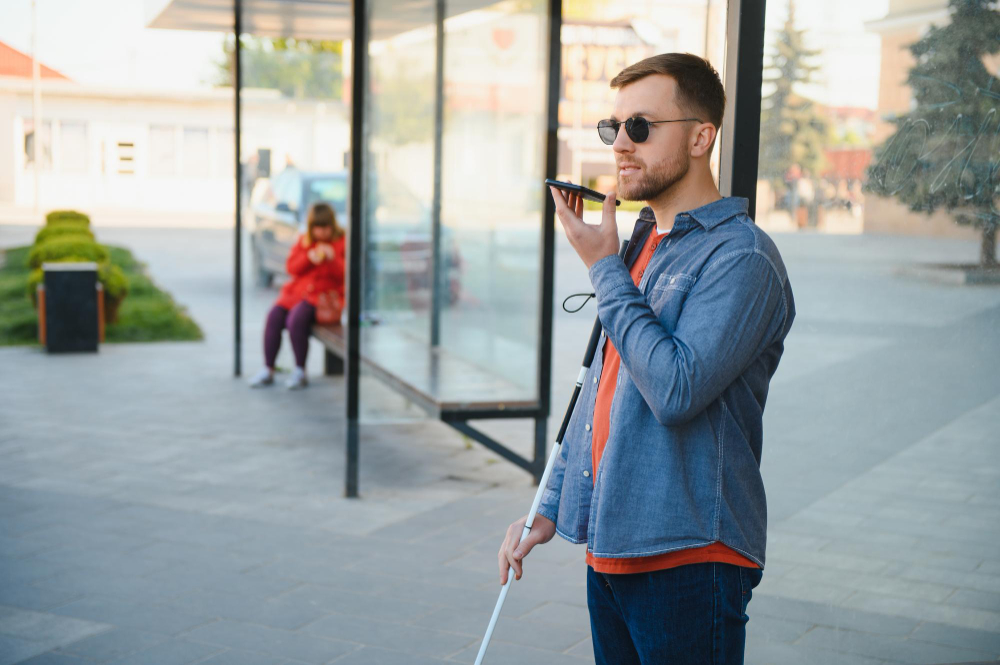
Smart vs. Automatic: What’s the Difference?
The market offers a wide array of electronic door control systems and home automation solutions. These systems are quite beneficial, operating on simple mechanisms such as unlocking with the press of a button and automatically locking the door a brief time later. However, what distinguishes a door as ‘smart’?
A smart system involves the Tedee smart lock being connected to a Tedee Bridge, which enables its features to be accessible over the internet. This combination allows users to monitor the status of their locks at any time and from any location. The true advantage of smart technology lies in the notifications that alert you when someone enters your property or in the convenience of confirming the door is locked by simply asking a voice assistant on your smartwatch.
The result is not just ease of use but also a more complete awareness of one’s premises. It enhances security consciousness rather than merely simplifying usage.
Therefore, we strongly recommend using the Tedee GO or Tedee PRO in conjunction with a Tedee Bridge. This setup connects your smart lock to the internet, enabling real-time access control, activity logs, and push notifications no matter where you are. Even if not utilized daily, the security advantages of this system significantly enhance the quality of life by increasing the sense of control over your environment. Learn more about the Tedee Bridge, after this link.
The Most Loved Smart Lock Features
Imagine returning home to find that your door lock automatically unlocks as you approach – no need for door keys or mobile apps.
Automatic unlocking is one of the most cherished features of smart locks. It employs multiple technologies to ensure security by monitoring who comes home and when. As a result, the door only unlocks automatically after a user has left and then returned to the vicinity of their property, and specifically when they re-enter the Bluetooth range, about 3-5 meters from the door.
Remember, this feature’s effectiveness benefits from fine-tuning the configuration of your setup, followed by practical testing and adjustments. Its reliability can be maximized over some initial use period.
Keep a digital “eye” on your door 24/7 and be informed about who, when, and how your place was accessed.
The activity logs of your smart locks offer unparalleled peace of mind and a sense of control over your premises. If you enable push notifications, you can receive real-time alerts if someone accesses your property when you’re away.
Tedee smart locks record every instance they are locked and unlocked. The complete history of events is always accessible in the Tedee app and can be read aloud by screen reader technology, providing a comprehensive report if anyone has passed through your door, even with a traditional key.
Wondering if you locked the door? Just ask the voice assistant on your smartphone.
Integration with the three main voice assistants in the market – Siri, Google Assistant, and Amazon Alexa – allows you to control the door lock not only via the accessible Tedee app but also through native voice commands. This feature lets you check the status of your smart lock or lock it simply by speaking to a voice assistant on any compatible device.
Please note that extra security measures might be required when unlocking the smart lock with voice commands. You may need to provide a preset access code or obtain a biometric authorization.
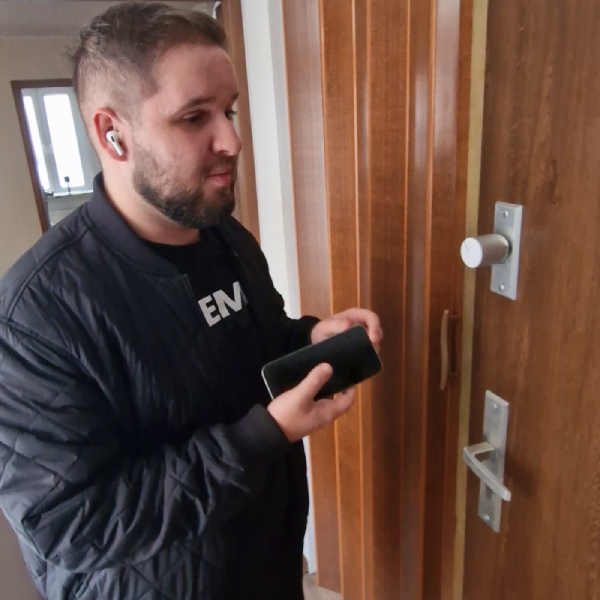
How is the Tedee App Accessible?
As all features of Tedee devices are integrated into the Tedee app, it has become the focal point of our efforts to enhance accessibility. Making the app accessible and efficient for users with vision impairment has involved an extensive process, which included assistive technology experts and users.
Screen reader technologies – VoiceOver on iOS and TalkBack on Android – offer a new way of interacting with smartphones that are less dependent on (or independent from) visual elements on the screen. These tried-and-tested procedures audibly read out screen elements in a predetermined manner and introduce new manual gestures, like clicks and finger swipes, enabling focused interaction without the need for precise tapping.
Both technologies employ similar yet consistent techniques and practices that standardize interaction across all apps, regardless of their function. This presents a challenge in adapting the app to assistive technologies, necessitating a completely different mode of use compared to the standard visual-based interface. As the Tedee app is essential for setting up and controlling Tedee devices, the entire process, including smart lock settings and account management, must be optimized for effective use with screen-reading technologies.
Many users of assistive technologies customize how apps are displayed and controlled on their smartphones. Therefore, each element of the app must be precisely designed as “building blocks” that can be rearranged using accessibility features.
The project’s goal was to evaluate, enhance, and ensure the app’s functionality by securing suitable text contrasts and containers, implementing easy-to-use controls, and optimizing user interface elements for gesture control. Adjusting the app for maximal accessibility with voiceover tools involved extensive UX and software development, from testing labels to ensuring that all user flows are comprehensive and easy to navigate using voice commands.
Our solutions have been intensively tested, improved, and fine-tuned based on direct feedback from assistive technology users, ensuring the complete accessibility of all the practical features of our smart locks.
How Tedee Works with Accessibility Features
Using native assistive technologies, such as VoiceOver for iOS and TalkBack for Android, all elements on the screen are audibly described by the system voice. Users can interact with these elements using gestures, including double taps and swipes, among others.
Video showing an iPhone’s VoiceOver system narrating the Tedee app interface. The screen displays a lock status feature with a prominent locked padlock icon in the centre. Below, there are two buttons: one labelled ‘Lock’ with a locked padlock symbol, and another labelled ‘Unlock’ with an unlocked padlock symbol. The VoiceOver highlights and audibly describes each interface element, which can be navigated and activated through on-screen gestures.
Users of assistive technology can engage with all the app’s features, from quickly controlling the smart lock to reviewing activity logs and adjusting detailed settings. They also have the option to rename on-screen element labels using in-system tools, allowing for further customization of their experience. Features like selecting a “favourite” smart lock streamline the app’s functionality by simplifying in-app processes.
More Than the App: Unlock the Door with a PIN on an Accessible Tedee Keypad
To reduce reliance on smartphones and provide an alternative way to unlock the door, the Tedee Keypad enables smart lock unlocking using a PIN.
The Tedee Keypad is a remote, wireless numeric keyboard designed to be mounted outside your door. It features two vertical rows of buttons, with digits from 0 to 9, and three functional buttons: one for activating the unlock mechanism after code entry, one for cancelling a previously pressed digit, and one for sending a push notification to the keypad owner.
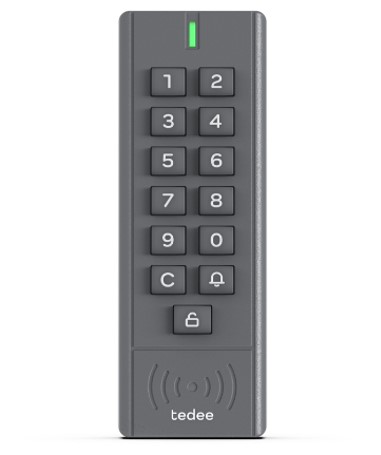
Installation is quick, connecting to the smart lock via Bluetooth. The keypad’s simple button layout, tactilely distinct “5” digit, and wide buttons, which can be customized with Braille stickers, make it user-friendly for customers with vision impairments. This design empowers them to unlock the door without keys or any other objects, simply by using a memorized access PIN.
Complete Access System from Street to Flat
The Tedee app, enhanced with accessibility features, can also control access points in shared areas. When installed at the main building door or fence gate, the BleBox Smart Relay Module extends the accessible app control to even third-party, analog mechanisms, all through the same user-friendly Tedee app. Its installation should be limited to professional installers.
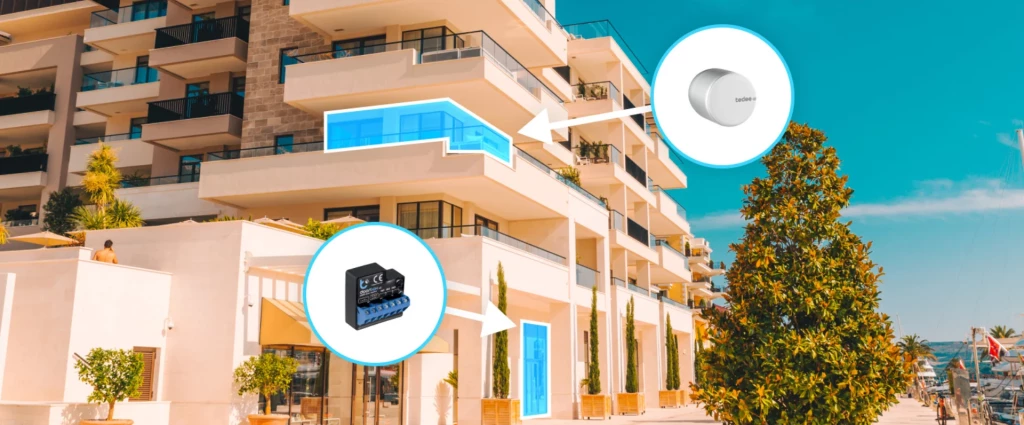
Further Accessibility Enhancements Coming Soon
Our ongoing collaboration with assistive technology experts and in-house developers is set to expand, with the introduction of new products and technologies that can be added to existing setups.
A door sensor will enhance the intelligence of the control system by providing information on the status of the door wing, not just the lock. It will indicate whether your door is closed or open, completing the information about whether the lock itself is secured or not.
The NFC reader is a hardware accessory enabling short-distance wireless communication. It’s already built into the Tedee Keypad but is currently inactive. In the future, a free software update will activate this feature, allowing the Tedee Keypad to unlock the door by touching it with authorized devices, such as dedicated keychains or smartphones equipped with active NFC technology and access authorization. Further details about these features will be announced in the future.
We’re also developing a method to control Tedee smart locks via an analogue, dry-contact connection. This will offer additional, simpler ways of controlling the lock, such as using a simple mechanic button, which could be especially beneficial for individuals with limited movement or manual capabilities.
Remaining Challenges
While the regular, everyday use of Tedee smart locks in the Tedee app is fully accessible to users with vision impairments, it’s important to note that some initial procedures or maintenance tasks might require handling small components or following visual guides, necessitating assistance.
We recommend that installation be conducted by fully sighted individuals or professionals, as it involves precise work with miniature components like screws, essential for optimal security of the property. Even after installation, certain service actions required in the event of hardware issues, such as calibration or factory reset, still necessitate reference to visual guides, like the exact position of lock bolts or LED indicators.
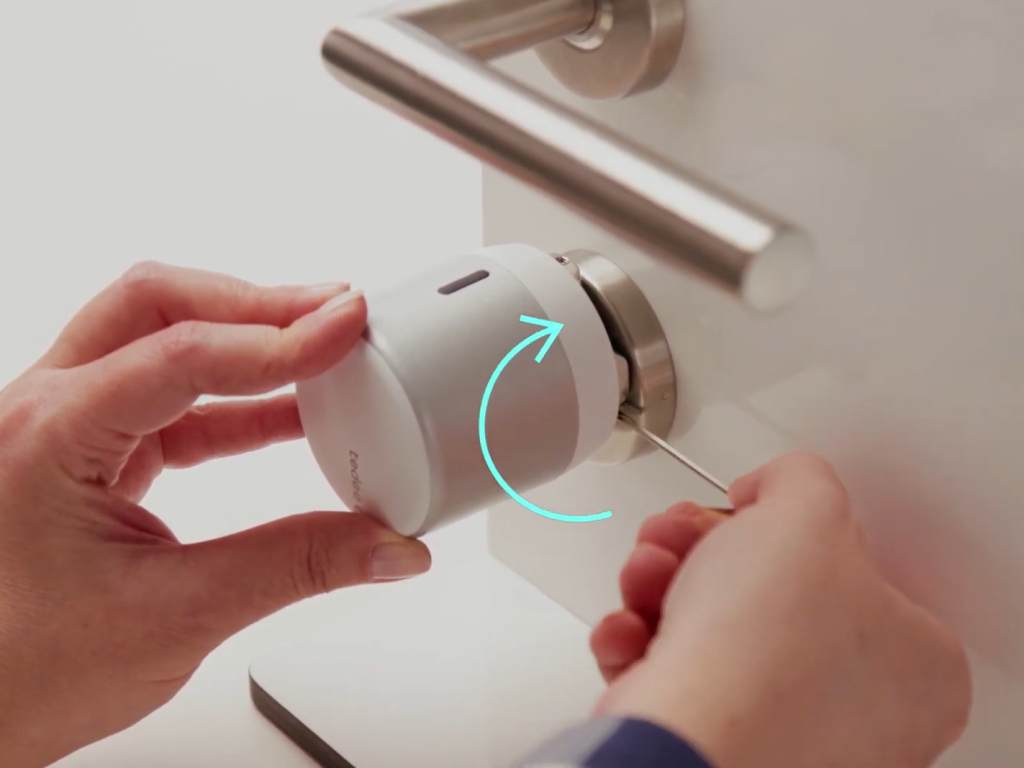
How to Start Using Tedee Smart Locks
Before purchasing, it’s crucial to decide whether the Tedee GO or Tedee PRO model suits your needs, as their installation methods, physical appearances, maintenance requirements, and prices differ.
Read more about the differences between the Tedee GO and Tedee PRO smart locks.
Both models provide the same digital features and access to the user-friendly Tedee app. Consulting an authorized Tedee distributor or a local locksmith can help select the hardware configuration that best suits your door.Based on our experience and partner testing, we recommend purchasing a Tedee smart lock along with a Tedee Bridge to fully benefit from features advantageous to users with vision impairments.
Find a Tedee partner seller in the store locator.
Our experience has shown that smart locks are often eligible for purchase through government financing subsidies and grants. However, terms and conditions vary between countries and local authorities. You may need to provide a pre-payment invoice or other documentation for such applications.
We are also eager to collaborate with companies, associations, and foundations working in the field of assistive solutions for people with vision impairments. We can facilitate bulk purchases or provide additional assistance.
Should you require any documents to apply for funding or you’re interested in cooperation, please contact us at [email protected]

















